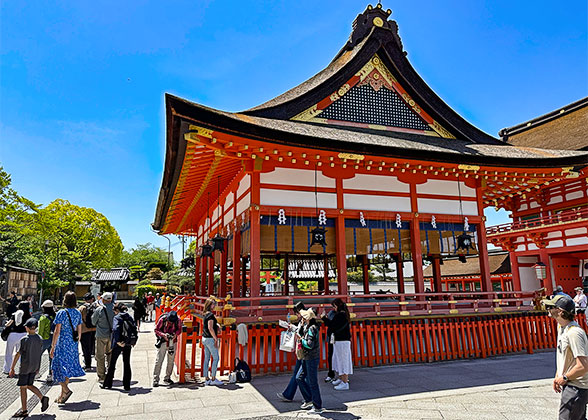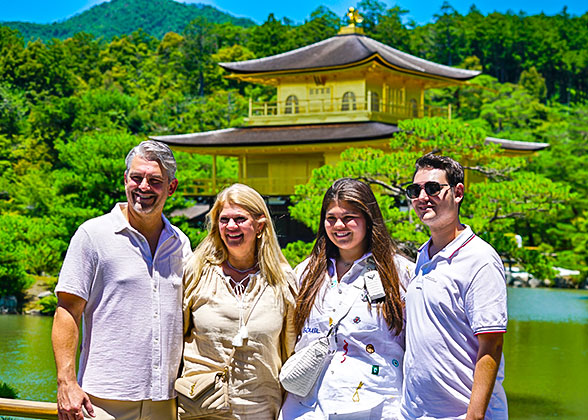Heian Shrine
Heian Shrine, also known as Heian Jingu Shrine, was built in 1895 to commemorate the 1,100th anniversary of Kyoto’s being the capital city of Japan since 794. It enshrines the first and the last emperors who ruled the country in Heiankyo (now Kyoto): Emperor Kanmu (737-806) and Emperor Komei (1831-1867).What to See in Heian Shrine
1. Biggest Torri Gate in Kyoto
At the entrance of Heian Shrine there is a 24-meter-tall vermilion torri gate built in 1928, which is the biggest torri gate in Kyoto. It stretches across an 18-meter-wide road as a striking landmark, greeting visitors and worshippers from all over the world.

Heian Shrine
|
2. A Replica of the Imperial Palace of Heian Period
The buildings of Heian Shrine are a 5:8 scale replica of the Imperial Palace of Heian Period (794-1185) which was constructed in the late 700s. The shrine buildings model after the architectural style of Chinese Tang Dynasty (618-907) with bright colors like vermilion, white and green. Inside Heian Shrine, the most representative Outemmon Gate and the main hall Daigoku-den are Japan’s designated Important Cultural Properties.3. Japanese Pond Gardens
The South, West, East and Middle Gardens in Heian Shrine were designated as National Site of Scenic Beauty in 1975. They are Japanese style courtyards called strolling pond gardens, in which visitors can enjoy the view of pond, pavilions and plants while strolling along the path. Various flowers are planted so that you may enjoy blossoms in all seasons.

Japanese Pond Gardens
|
Things to Do in Heian Shrine
1. Watch “Coming of Age” Ceremonies in January
According to Japanese tradition, Coming of Age Ceremonies are held on the second Monday of January every year to celebrate young people’s maturity - usually at the age of 20. On this special day, young women often wear furisode - a kind of kimono with exquisite long sleeves, and young men may wear a suit or hakama. The new adults will together worship and take photos in Heian Shrine after the ceremonies.

Girls attending coming-of-age ceremony
|
2. Enjoy Cherry Blossoms in April
There are about 300 cherry blossom trees in the four pond gardens of Heian Shrine, of which the South and East gardens attract both locals and foreigners every year with the stunning weeping cherry blossom trees called Yae-Beni-Shidare. This kind of cherry blossom trees feature its drooping branches covered with glorious pink blooms in April.

Sakura in Heian Shrine
|
3. Watch Jidai Matsuri - Festival of the Ages in October

Heian Shrine in Autumn
|
4. Explore Kyoto Heian Antique Market
This antique market is held usually on the 10th of every month in front of Heian Shrine, in which there are around 150 stalls selling antiques, crafts, second-hand clothes or books, etc. Strolling around the market is a good way to know some stories behind the antiques and catch a glimpse of Kyoto’s local flavor.Know Before Going
1. Opening Hours
|
Date |
Opening Hours |
|
Feb. 15 to Mar. 14 |
6:00 - 17:30 |
|
Mar 15 to Sep. 30 |
6:00 - 18:00 |
|
October |
6:00 - 17:30 |
|
Nov. 1 to Feb. 14 |
6:00 - 17:00 |
2. Ticket Fare
Free; but the ticket of the four gardens inside is 600 JPY per person.
How to Get to Heian Shrine
1. By bus
Take the Kyoto City Bus 5, City Bus EX100, City Bus 105, City Bus 46 or City Bus 86 to Okazaki Koen Bijutsukan/Heian Jingu-mae and walk north for about 1 minute to get to Heian Shrine.2. By subway
Take subway Tozai Line to Higashiyama Station and walk north for about 7 minutes to reach it.Nearby Attractions
Yasaka Shrine: The place where Japan’s most celebrated Gion Festival is held. You may walk south for about 15 minutes to reach it. And it’s also convenient to take the Kyoto City Bus 86 from Okazaki Koen Bijutsukan/Heian Jingu-mae to Gion, the cost of which is 230 JPY.Philosopher’s Path: A long path for cherry blossom viewing, along which there are many shrines and famous temples. You may walk east for about 19 minutes to get there.
Kamo River: Also named as Kamogawa River, it’s a 31-km-long river flowing through the heart of Kyoto. You may walk west for about 14 minutes to reach the riverbank.




